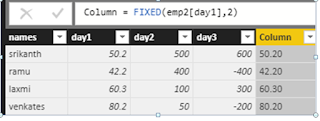Exact function (DAX)
Compares two text strings and returns true if they are exactly the same, false otherwise. Exact is case-sensitive but ignores formatting differences. You can use exact to test text being entered into a document
Syntax
Exact (<text1>,<text2>)
Step2
Find function (dax)
Returns the starting position of one text string within another text string. Find is case-sensitive.
Syntax
Find(<find_text>,<within_text>,[,[<start_num>][,<notfoundvalue>]])
Step2
Search function (dax)
Returns the number of the character at which a specific character of text string is first found, reading left to right search in case-insensitive and accent sensitive.
Syntax
Search(<find_text>,<within_text>[,[<start_num>][,<notfoundvalue>]])
Substitute function (dax)
Replaces existing
text with new text in a text string
Syntax
Substitute(<text>,<old_text>,<instance_num>)
Step2
Replace function
(dax)
Replace replaces part
of a text string, based on the number of characters you specify, with a
different text string.
Syntax
Replace(<old_text>,<start_num>,<num_chart>,<new_text>)
Rept function (dax)
Repeats text a given
number of times. Use rept to fill a cell with a number of instances of a text
string.
Syntax
Rept(<text>,<num_times>)
Trim function (dax)
Removes all spaces
from text except for single spaces between words.
Syntax
Trim(<text>)
Mid function (dax)
Returns a string of
characters from the middle of a text string, given a starting position and
length.
Syntax
Mid(<text>,<start_num>,<num_chars>)
Fixed function (dax)
Rounds a number to
the specified number of decimals and returns the result as text. You can
specify that result be returned with or without commas.
Syntax
Fixed(<number>,<decimals>,<no_commas>)
Step2
Statistical function
Min function (dax)
Returns the smallest
numeric value in a column, or between two scalar expressions. Lgnores logical
values and text.
Syntax
(<column>)
Max function (dax)
Returns the largest
numeric value in a column, or between two scalar expressions.
Syntax
Max(<column>)
Crossjoin Function
(dax)
Returns a table that
contains the Cartesian product of all rows from all tables in the arguments.
The columns in the new table are all the columns in all the argument tables.
Syntax
Crossjoin(<table>,<table>[,<table>]…)
Step1
Step2
Step 3
Rankx function (dax)
Returns the ranking
of a number in a list of numbers for each row in the table argument.
Syntax
Rankx(<table>,<expression>[,<value>[,<ties>]]])
Step1
Measure = sum(financials[ Sales])
Step2
Measure 2 = RANKX(ALL(financials[Country]),[Measure],,DESC,Dense)
Topn function (dax)
Returns the top n
rows of the specified table.
Syntax
Topn(<n_value>,<orderBy_exprssion>,[<order>[,<orderBy_expression>,[<order>]],,,])
Step2
Row function (dax)
Returns a table with
a single row containing values that result from the expressions given to each
column
Syntax
Row(<name>,<expression>[[,<name>,<expression>],,])
Step2
Countblank
function(dax)
Counts the number of
blank cells in a column
Syntax
Countblank(<column>)
Distinctcoun function (dax)
The distinctcount
function counts the number of distinct values in a column
Syntax
Distinctcount(<column>)
Countrows function
(dax)
The countrows
function counts the number of rows in the specified table, or in a table
defined by an expression.
Syntax
Countrows(<table>)



























No comments:
Post a Comment